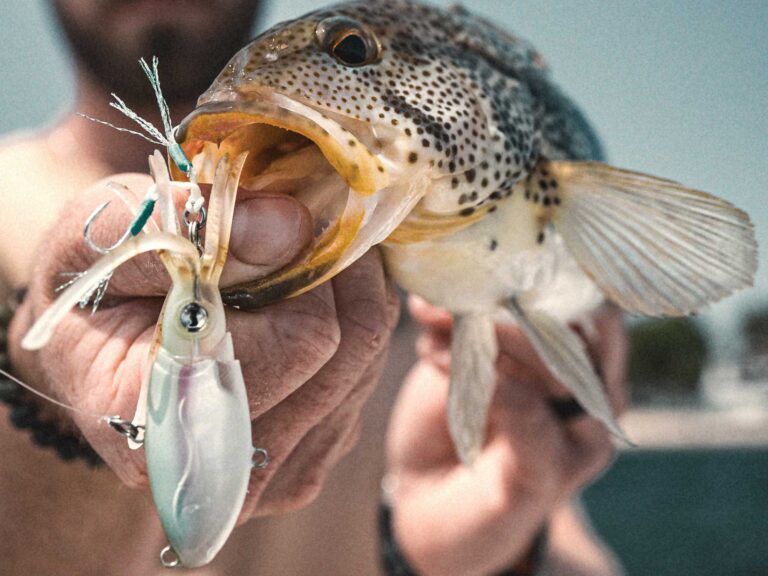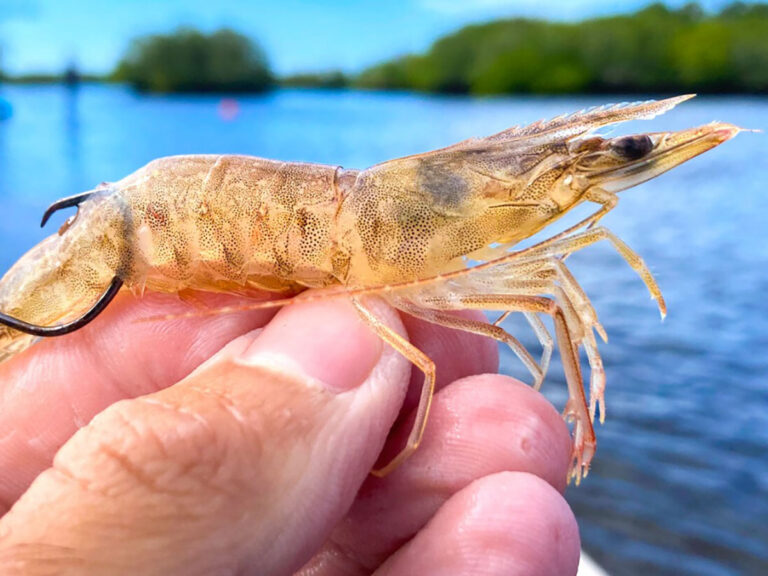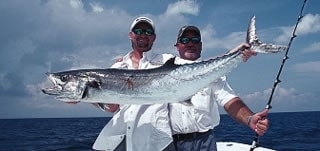
| The 2003 champions of the Southern Kingfish Association Texas Division 8 Championship, Dr. Jose Reyes, right, and Bill Platt caught this tournament-worthy king mackerel over a wreck about 80 miles out of Galveston, Texas. |
Catching king mackerel off the Texas coast during the summer can be as easy as trolling a feather jig past any oil or gas rig in 20 to 500 feet of water. But catching trophy-class kings, on a regular basis, is another ball game.
Two anglers who have figured out how to find and catch big, tournament-winning kings are Captain Bill Platt and Dr. Jose Reyes, both based out of Galveston on the upper Texas coast. The two men teamed up to win the Southern Kingfish Association (SKA) 2003 Texas Division 8 Championship with a 52.27-pound king.
“That was a big fish,” recalls Platt. “It put us over the nearest competition by about 20 pounds. We caught it over a wreck, about 150 miles east of where the tournament was being held on the middle Texas coast.”
Fast and Far
| ### Quick Tip”When bump-trolling live baits for big kings, you don’t need to set the hook when you get a bite,” says Captain Bill Platt. “I bump-troll with a light drag. When a king hits and takes off with the bait, I take the rod out of the holder and slowly tighten the drag. The hook will automatically set, and the fight is on.” |
Platt and Reyes run a 36-foot Contender powered by three 300-hp Yamahas, which move them along at 65 miles per hour. All that speed is backed up with a 500-gallon fuel tank. “We don’t like to fish around the competition,” says Platt. “I like to keep my locations a secret. That’s why we use a fast boat that’s got the fuel and the range to fish from just about any tournament location. Most of the time we’ll be fishing anywhere from 80 to 100 miles out. To do that you need a fast boat that can handle some rough seas.”
For years, Platt has operated an offshore charter service out of Galveston. During that time he has collected quite a few GPS numbers to some pretty good fishing locations, most of them wrecks. “I’ve got a book full of numbers,” says Platt. “And most of them don’t get fished very often. Most are wrecks, but some are live reefs.”
What Platt means by a “live reef” is one that holds snapper. Live reefs can include mud lumps, coral outcroppings or abandoned well heads. “Anywhere you’re catching snapper, you can rest assured that big kings are going to be somewhere in the area,” says Platt.
Once on location, Platt and Reyes use their Furuno 580-2L depthsounder to detail what kind of structure they are fishing. “I like to use a 1,000-watt, in-hull transducer,” says Platt. “I can read the bottom better with that rather than something like a 600-watt transducer. It costs a little more, but the image quality is worth it.”
A Day with the Pros
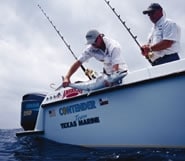
Reyes and Platt show how it’s done.|
To learn firsthand how Reyes and Platt apply their king-catching skills, I tagged along with them for a day. When I met them at the Tiki Island Marina in Galveston at 9:00 a.m., Reyes revealed the game plan. “We’re going to run out about 80 miles and see what’s biting,” he said casually. “Be back this afternoon.”
“Say what?” I asked. “I don’t recall ever leaving this late in the morning for a one-day trip that far out.”
“The seas are pretty much flat,” Reyes replied. “As long as we can run wide open, we own the Gulf.” He wasn’t bragging. In no time flat we had put 80 miles of ocean behind us, pausing only to catch a dozen or so hardtails (blue runners) to use as live bait.
“We’re going to be fishing a wreck that I haven’t fished in a few years,” Platt explained as we ripped across the water. “But it’s a wreck that always holds big snapper and lots of baitfish.”
When we arrived at the wreck, the structure was clearly visible on the depthsounder, which had been personally tweaked by Platt to show a detailed image of the bottom structure. “See those big, bright areas?” he said. “That’s all baitfish and red snapper. I’m betting that we’re going to catch a big king here.”
| ### Bait Placement & Fighting Strategy |
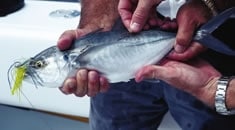
While 10- to 12-inch hardtails are great bait for kings, Platt says bigger baits bring bigger catches.|
Once SKA champions Captain Bill Platt and Dr. Jose Reyes and reach their designated fishing spot, they set a spread of five lines. Two are fished off rods placed in outward-facing holders on the hard top and two are fished off the port and starboard downriggers. The fifth rod is fished down the center.
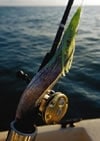
Fresh-dead ribbonfish baits are rigged with multiple hooks and fished behind skirts. |
“We like to pull the outside baits 30 to 40 yards back,” says Platt. “The downriggers are set from 30 to 40 feet deep, or ten to 20 feet off the bottom. The center rod is set to pull a bait in the prop wash, about ten yards back.”
When a king takes the bait, one angler grabs the rod and makes sure the fish is on, then proceeds to the bow. The next step is to clear all the lines and follow the king as the angler frantically reels to gain line. The trick is to keep a tight line as the boat gains on the king. The idea is to get the fish in the boat as soon as possible. This helps eliminate the chance of a thrown hook or equipment failure. Plus, it reduces down time – the quicker they get a king to the boat, the more time they have to fish.
We set out two lines, each rigged with a ten- to 12-inch hardtail, and began bump-trolling them over the wreck. A few minutes later, both baits were whacked at about the same time. And just like that we were hooked up with a pair of huge kings, one of which pushed the 50-pound mark on a handheld scale.
“That’s a tournament winner,” Reyes exclaimed. “I’ll take a king of that size any day.”
In the hunt for trophy kings, live bait is the key to success. “It’s the only way to go,” states Reyes. “We don’t ever use lures in a tournament. If you’ve got a live well full of hardtails, you are way ahead of the game. However, we’ll also use big, fresh-dead ribbonfish when available.”
Platt and Reyes most often fish ten- to 12-inch hardtails, but point out that 12- to 15-inchers will often select for bigger kings. During summer, hardtails are easy to catch around most rigs in 30 to 50 feet of water. That’s where you can normally find lots of ten- to 12-inchers.
Making Bait
Platt and Reyes often use a Sabiki rig weighted with a three-ounce sinker to catch their hardtails. “The blue, red and white Sabiki rigs work best,” says Platt. “But the main thing is to get the rig in front of the fish.”
That can be hard to do if the hardtails dive at the approach of a boat. If this happens, making long-distance casts with a 1/2-ounce gold spoon can be the way to go. “In most situations we’ll use the Sabikis because they catch more hardtails per cast,” says Reyes. “But it’s always good to have a spoon rigged and ready for when the fish are spooky. Also, the spoon will often catch the bigger hardtails.”
Reyes and Platt like to load up with about 40 to 50 hardtails before heading to their first spot. Their boat has two 40-gallon live wells that circulate 1,100 gallons of water per hour. That much water keeps the baits lively all day, and even through the night for another day of fishing.
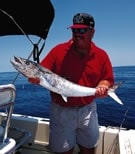
Kingfish pros aren’t afraid to run away from the crowd and find their own action.|
Trophy Tackle
When it comes to tackle, Platt and Reyes use seven-foot King Buster American Rodsmiths rods rated for 20- to 30-pound line. Reels are Shimano Trinidad 20s spooled with 30-pound Sufix line. The end of the main line is tied to a 50- or 80-pound-test, black barrel swivel. A five-foot, 61-pound-test Malin wire leader is connected to the other eye of the swivel using a haywire twist. The Malin wire is made of stainless steel with a small amount of silver to give it softness while retaining strength. Its tobacco-brown finish is non-reflective (very important) and practically invisible in the water.
Like most other live-bait anglers looking for kings, Reyes and Platt use a combination of hooks. The front hook is a 4/0 Mustad Live Bait Ultra Point single hook. The rear hook is a No. 4 Mustad 4X Kingfish treble. The distance between the two hooks is usually seven inches. For big hardtails they use two trebles. And for ribbonfish they use a live-bait hook in the head of the bait followed by three trebles in the body.
The most important part of Platt’s and Reyes’s game plan is having the numbers to productive wrecks and reefs in the areas they plan to fish. Once they reach a location, they give it 30 minutes to an hour to produce. If they start catching small kings, they leave almost immediately. However, if they hook a solid fish (40 pounds plus), they’ll hang around a while longer.
Look for Green Water
| ### Get The NumbersHilton’s Offshore offers updated, highly detailed charts of the Gulf marked with all sorts of great bottom structure. The charts also list the GPS numbers for hundreds of potential trophy-kingfish hot spots, including rocks, wrecks, reefs and more. The charts show 3-D bottom features and are waterproof.For detail go to www.hiltonsoffshore.com or call (281) 431-0925. |
According to Platt, water temperature is not overly important to finding kings. “I pay a lot more attention to water color and the amount of baitfish than temperature,” he says. “‘King-green’ water is always best for the big boys. I don’t like to fish the clear blue water. Big kings will use the green water, with less visibility, to feed in most of the time.”
Platt adds that an advantage of running a big, fast boat is the ability to cover lots of water. “If you’re fishing a rip or some sort of color change, you can stay in that area all day,” he says. “On the other hand, if you’re fishing wrecks and live reefs, you’ve got to be able to move from one location to another without wasting too much time. That’s when a fast boat with plenty of fuel and range will put you on big kings when other boats can’t find them.”
The best time to target big kings off Texas is from May through September. The great thing about fishing the Gulf is that regardless of where you fish, there are plenty of wrecks and reefs to choose from. And more often than not they will be holding big kings.






